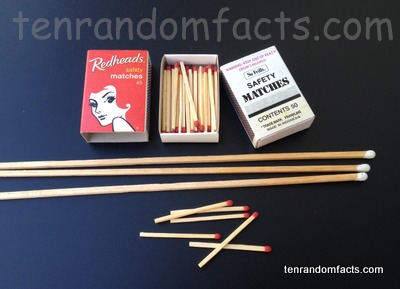Strike a flame with a match.
- Matches are disposable items useful for the convenient and inexpensive ability to quickly light a flame.
- Typically matches are a wooden or cardboard stick with an end cap, called a ‘head’, that ignites under friction.
- Heads of matches are commonly made of phosphorus sesquisulfide, potassium chlorate, or antimony (III) sulphide.
- The term ‘match’ comes from the word ‘meiche’, meaning ‘candle wick’ in Old French.
- There are two main variants of matches, ‘safety’ variants, which generally cannot alight unless stricken upon a specially made material; and those that can ignite using friction on a dry, rough surface, known as ‘strike-anywhere’ variants.
- Simple matches originated from as early as the mid 950s in China as sulphur-dipped wooden sticks, although they were possibly used a few hundred years earlier.
- A variety of matches were invented in the early 1800s, including the chemical match in 1805, by Jean Chancel of Paris, France, although most were not safe or economical.
- The first practical match to light through friction was invented by the Englishman John Walker, a chemist, in 1826, and improvements were made to it in 1830, by Charles Sauria of France.
- A striking surface especially made for matches originated in Sweden, invented by Gustaf Pasch in 1844, notably using red phosphorus, as opposed to the previously used white phosphorus heads, and this was the beginning of the ‘safety’ version.
- Surfaces made for match striking typically contain red phosphorus, glass crystals, carbon black, a binder and a neutraliser.





